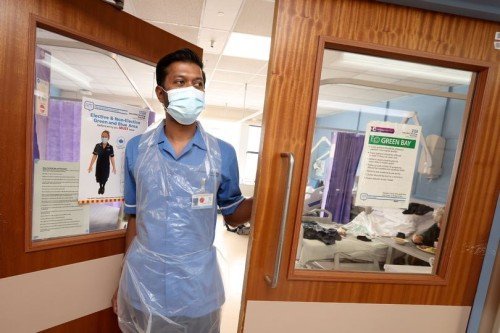
The number of people being treated specifically for Covid-19 in Welsh hospitals is the highest it has been since mid-July, latest figures have revealed. On Tuesday, December 20, of the 538 patients in hospital with "confirmed" Covid, 72 of them were being actively treated for the virus - the most since July 22 (77 patients).
However there remain very few coronavirus patients needing the most serious form of treatment in critical care. Of the nine "confirmed" Covid patients in critical care beds, only five were being treated specifically for the virus. The most there has been all year in these types of beds is 26.
The figures come as hospitals across the country struggle with overwhelming levels of demand. On December 19 Betsi Cadwaladr University Health Board in north Wales declared an "internal critical incident" due to incredibly high patient volumes. It said a combination of winter viruses, parents seeking help due to concerns about strep A and injuries related to the cold weather were to blame.
According to latest data from the Office for National Statistics (ONS) infection survey there has only been a very slight rise in Wales' overall infection rate. For the week ending December 8, the estimated number of people testing positive for Covid was 57,600 which equates to 1.89% of the population or around one in 55 people. The previous week the figures stood at 55,900 infections which is 1.84% or around one in 55 people.
Other parts of the UK, including England and Scotland, are continuing to see a rise in cases. The total number of people in private households in the UK testing positive for coronavirus stood at 1.4 million in the week to December 9. This is the highest UK-wide total since the end of October.
Sarah Crofts, deputy director for Covid-19 infection survey analysis at the ONS, said: "Today's data show that Covid-19 infections have risen for the fourth consecutive week in England, with cases also continuing to rise in Scotland. Over half of English regions saw an increase, while it's a mixed picture for different ages. Infections have increased among most adults under 70, while secondary school age children experienced a decrease in infections. We will continue to monitor the data closely over the coming weeks."
Infections in England have risen for the fourth week in a row and stood at an estimated 1,197,200 in the week ending December 9, the equivalent of one in 45 people. This is up from 1.1 million, or one in 50, in the week to December 5.
In Scotland, 130,900 people were estimated to have Covid-19 in the latest week, or one in 40, up from 100,700 or one in 50. In Northern Ireland, the number of people testing positive for Covid-19 stands at 37,000, or one in 55, compared with 38,700 in the previous survey, or one in 40.
Meanwhile, recent ONS data shows the Covid-19 age-standardised mortality rate for Wales was 19.9 deaths per 100,000 people in September 2022, compared to 81.0 deaths per 100,000 people in January. The rate in England was 16.7 deaths per 100,000 in September 2022 compared to 79.3 per 100,000 in January.
Ischaemic heart diseases (3,216), dementia and Alzheimer's disease (3,073), chronic lower respiratory diseases (1,641), malignant neoplasm of trachea, bronchus and lung (1,510) and cerebrovascular diseases (1,396) all had more registered deaths in Wales than Covid (1,167) between January and October this year.








